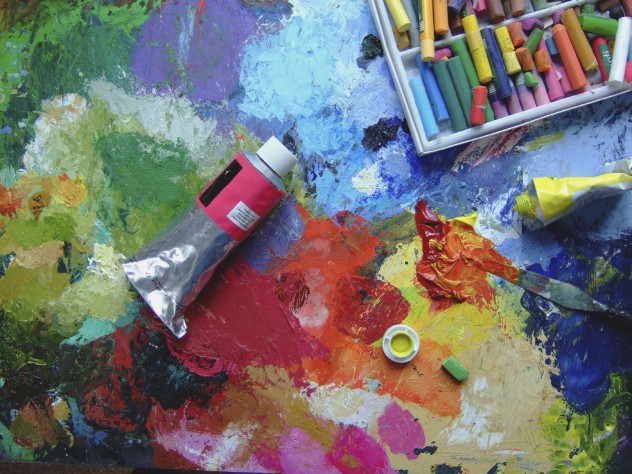Human beings have bodies.
Obvious? Maybe. But few people seem to teach accordingly. The fact we have bodies has HUGE educational implications. It means that wherever we are, we have a set of tools that help us to learn new things and to make sense of our experiences. Kieran Egan’s theory of Imaginative Education reminds us of this: our bodies are the primary means through which we make meaning in the world around us. Unfortunately, this fact—that all learners have bodies—is far too often forgotten in education.
After elementary school, it is unusual to see educators employing teaching and learning practices that engage the body. When I was a secondary school teacher I rarely saw embodied practices in any classes other than Fine Arts and PE. At that time, I didn’t consider how to employ the body in teaching my students French grammar or history. I heard nothing about the body’s role in learning when I did my teacher training. Now, at my university, I rarely hear my colleagues discussing how to deepen meaning in their graduate/undergraduate courses in ways that engage the body. This is a huge problem.
One of the dangerous misconceptions we continue to hold in education is the sense of the “rational mind” as somehow divorced from the feeling body. Many educators do not appreciate or understand the ways in which the body’s tools can deepen and enrich all learning.
Have you heard of the “Dance Your PhD” contest? This contest challenges PhD candidates to express their thesis findings and conclusions through their bodies. Here we have examples of the most academic and theoretical concepts being conveyed through the body. For example, in the Biology category, Florence Razoux dances the PhD thesis, “Functional MRI to assess genetic and environmental influences on serotonergic neurotransmission in mice.” In the Physics category Kiel Howe dances the PhD thesis, “Extending the Supersymmetric Little Hierarchy.” The winner of the 2015 contest in the Social Sciences category is Florence Metz who dances the PhD thesis, “Do Policy Networks Matter to Explain Policy Design?” Enjoy:
You might enjoy a quick look at the 31 entries from 2015. My point is that these academic topics are far from “elementary”—and yet the BODY is engaged in expressing these incredibly complex ideas. Clearly, the body’s role in learning is not just “for kids.” (P.S. My interest in the body’s role in all learning has also led me to the work of Dr. Susan Gerofsky from the University of British Columbia who looks at embodied ways to learn Math—reference below.)
Of course, dancing isn’t the only way to engage the body’s learning tools. I don’t dance for my students nor do I insist that my students dance if they are not comfortable doing so. But I do ask them to convey complex and abstract ideas from our seminars through postures or gestures. And I do teach in ways that reveal patterns. And I do employ the body’s senses.
Read on to discover how to engage the body in your teaching.
4 Easy Ways To Engage The Body’s Learning Tools
The following tips are for all teachers/instructors/professors in all subject areas. When we can contribute body-based understanding we deepen and enrich understanding. We engage emotion and contribute to meaning. I have only included a few examples here. (Please LEAVE A COMMENT and share your own examples!)
#1 EMPLOY GESTURE.
 Human beings are gesturing animals. We use our bodies to show intention and express meaning. We point at things we notice (good and bad). We have body language to express emotions. Use this learning tool in multiple ways through “charades” type games. (But no “sounds like”!) Challenge your students to use the body to express an idea or concept, character, word, event, or process. Students can be asked to justify and explain their movements and how they reflect meaning of a topic/concept/idea.
Human beings are gesturing animals. We use our bodies to show intention and express meaning. We point at things we notice (good and bad). We have body language to express emotions. Use this learning tool in multiple ways through “charades” type games. (But no “sounds like”!) Challenge your students to use the body to express an idea or concept, character, word, event, or process. Students can be asked to justify and explain their movements and how they reflect meaning of a topic/concept/idea.
Science: What postures or gestures would convey different elements in the Periodic Table? (Great resource by Donna Dickens: 112 Cartoon Elements Make Learning The Periodic Table Fun. The artist of all these characterizations of the elements is Kacie D. Students could take on these “characters” and use their bodies to learn and convey different properties.)
#2 SEEK PATTERNS.
Human beings are very skilled at noticing and making sense of patterns of all kinds. Indeed, we do so all the time; if we didn’t we wouldn’t be able to do things like speak a common language, do math, or read a map. We couldn’t get by day to day. Sure, you are probably thinking that the dancers, painters, poets, and musicians of the world are exceptionally good at identifying, evoking, and conveying emotion through patterns of movement, rhyme and rhythm. You need not be a virtuoso musician, artist or dancer to engage these tools however. All human beings do so all the time. 
So, this means that you can encourage your students seek all kinds of patterns in topics (conceptual, procedural, visual etc.) What cycles are seen in the topic? What is repeated? Why?
Human beings also identify and appreciate the patterns of sound around us; we enjoy music. We are musical animals. Ideas can be conveyed through sound. How? You can ask students: If this concept or topic was a drum beat or a stomping pattern, what would it sound like? Beyond the drum, how might pitch, tone or tempo—how might music—reveal the topic? Students can create sounds that evoke some pattern of meaning or idea.
Social studies: How can rhythms express different forms of government—Democracy vs. Communism vs. Totalitarianism etc.? (Students can also provide an explanation/justification of their chosen sound).
#3 ENGAGE THE SENSES.
We are sensory animals and our senses frequently evoke emotional responses. How can we feel, touch, taste, smell, or hear the topic at hand? Or how would a concept feel, touch, taste, smell, or sound? What’s important to note from the sensory experience is the feeling tied up with the knowledge gained.
Science: Experience animal adaptation: Blubber glove—Steve Spangler Science
#4 TAP INTO YOUR STUDENTS’ EMOTIONS.
 Perhaps the most important thing to remember for learning is that we are emotional animals. Feeling is the way to remembering. So how are strategies #1-3 listed above (and other tools of imagination) engaging emotion?
Perhaps the most important thing to remember for learning is that we are emotional animals. Feeling is the way to remembering. So how are strategies #1-3 listed above (and other tools of imagination) engaging emotion?
That’s your aim as an imaginative educator: to leave your students feeling emotionally connected to topics by shaping your teaching in STORY FORM. (p.s. That’s Teacher Tip #1—find it here.)
Final Comments
It’s worth repeating: all learners have bodies. We have a body-based kind of understanding that we can engage and develop in all learning. We are perfinkers—we have embodied minds so “learning” involves perceiving, feeling and thinking at the same time. (Learn more about what a PERFINKER is or follow @perfinker…that’s me!)
TELL US—How do you teach in ways that engage the body?
Learn More
Gerofsky, S. (2013). Learning mathematics through dance. In G.W. Hart & R. Sarhangi (Eds.), Proceedings of Bridges 2013 Eschede, NL: : Mathematics, Music, Art, Architecture, Culture. Saxon University, Enschede, NL, 337-344.). (Dr. Gerofsky’s publications cover a range of embodied mathematical practices!)
Read all the TIPS FOR IMAGINATIVE TEACHERS in the Tools of Imagination Series.

